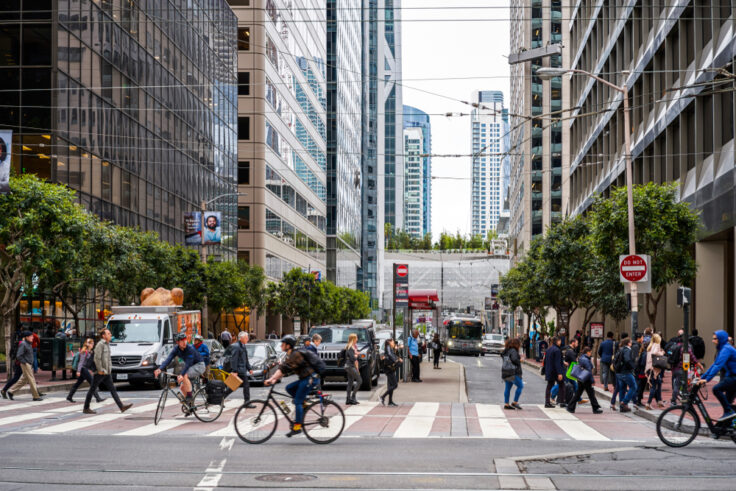January 10, 2024
Compact, Electrified Cities Can Greatly Reduce Emissions and Costs in the US
For the US, one of the top greenhouse gas emitters globally, significant changes will be needed in the transport sector to reduce emissions and leverage the economic benefits of sustainable urban development.
Access the Executive Summary and full report on the United States here.
 The recently released Compact Cities Electrified: United States from ITDP and UC Davis makes a case for the environmental, social, and economic impacts of shifting urban mobility towards compact cities built around walking, cycling, and public transit alongside large-scale transport electrification. The report finds that the US could feasibly reduce public-sector expenditures on urban transport at the city, state, and federal levels by a cumulative $2 trillion USD through 2050 using a combination of strategies that support electrification, compact city planning, and sustainable mobility. For individuals, the research also estimates that by 2050, such shifts could save each urban American an average of $2,000 USD every year. What’s more, combining these strategies will reduce carbon emissions from the national transport sector enough to meet the nation’s climate goals—but no single strategy would be enough to do so.
The recently released Compact Cities Electrified: United States from ITDP and UC Davis makes a case for the environmental, social, and economic impacts of shifting urban mobility towards compact cities built around walking, cycling, and public transit alongside large-scale transport electrification. The report finds that the US could feasibly reduce public-sector expenditures on urban transport at the city, state, and federal levels by a cumulative $2 trillion USD through 2050 using a combination of strategies that support electrification, compact city planning, and sustainable mobility. For individuals, the research also estimates that by 2050, such shifts could save each urban American an average of $2,000 USD every year. What’s more, combining these strategies will reduce carbon emissions from the national transport sector enough to meet the nation’s climate goals—but no single strategy would be enough to do so.
This new research demonstrates that the US can achieve a crucial Electrification + Shift scenario, and it will not require any additional funding beyond the resources that the nation already expends for urban passenger transport—indeed, the Electrification + Shift scenario would require less government funding than doing Business As Usual, meaning that more government resources could be used for other areas of development or to lower taxes. Instead, Electrification + Shift would only require a change in policies and a reallocation of current resources.
The report estimates that by 2050, transport electrification and compact city planning could save urban Americans an average of $2,000 USD a year.

The report’s release and findings were highlighted at an invitation-only event in January 2024 hosted by ITDP and Transportation For America (T4A) in Washington, DC. The meeting convened national transport advocates, government officials, NGOs, and researchers to discuss opportunities for decarbonizing the US transport sector based on Compact Cities Electrified and the US Department of Transportation (DOT)’s National Blueprint for Transportation Decarbonization.
The discussion included USDOT representatives who spoke on federal funding initiatives for sustainable urban development and electrification and highlighted areas for potential progress. ITDP, UC Davis, and T4A further made the case for the significant cost, energy, and emissions reductions possible with Electrification + Shift strategies that transform individual behaviors and system-level policies.
Among the highlights in the report, it identifies three critical elements that must come together to achieve an Electrification + Shift scenario. These include increased vehicle efficiency, primarily through electrification; land-use reform to make trips shorter by promoting compact mixed-use cities; and modal shift, primarily facilitated by providing alternative infrastructure, but also by pricing car travel according to its actual cost.
ITDP’s D. Taylor Reich and UC Davis’ Lew Fulton, co-authors of the report, presented their research at a January 2024 meeting in Washington, DC.

The research offers specific, measurable goals for achieving the three elements by 2050:
- Transport Electrification: Ensuring 100% of all new light-duty vehicle sales (cars and light trucks) are electric;
- Land Use and Development: Promoting plans and policies that increase average urban population density to 17,000 people per square mile (similar to the city-wide average of Los Angeles, CA);
- Transport Infrastructure: Building networks for public transit, cycling, and walking that reallocate resources from urban roads to entirely cease the construction or widening of urban roadways, instead adding 190,000 lane-miles of protected urban cycle lanes, 26,000 lane-miles of bus rapid transit, 2,600,000 more buses, and 18,000 more train cars, among other targets detailed in the report.
The US report is the latest country-specific report from ITDP and UC Davis based on the Compact City Scenario–Electrified research released in 2021, in which the researchers modeled global changes necessary to decarbonize urban passenger transport and identified the importance of vehicle electrification combined with modal shift. While the original report was global in nature, this ongoing series of reports examines regional contexts and data to outline scenarios for various countries. The first two focused on Egypt and India to assess similar ambitious, but feasible, scenarios for the future of each country’s urban transport sector.
This landmark analysis for the US provides clear evidence and a call to action for government and transport decision-makers to prioritize electrification and compact planning in both policy and practice.
Stay up-to-date on the release of future Compact Cities Electrified reports.
